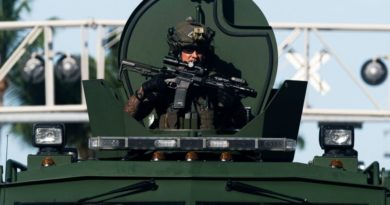US Air Force Reveals The B-21 Raider Stealth Bomber
In Palmdale, California on Friday, Northrop Grumman CEO Kathy Warden revealed a US Air Force warplane that had only been shown in artist renderings and is supposed to be seldom seen, the B-21 Raider.
“The B-21 Raider changes everything, reaffirming peace through deterrence, advancing technology and ushering in a new paradigm in aircraft design, development, and manufacturing,” said Warden. “With this aircraft, we’re delivering the next generation of stealth technology designed for the US Air Force to meet its most complex missions.”
The sixth generation stealth bomber is designed to operate over long ranges in both nuclear and conventional roles while remaining more or less invisible to radar.
“The B-21 Raider is the first strategic bomber in more than three decades,” said US Secretary of Defense Lloyd Austin. “It is a testament to America’s enduring advantages in ingenuity and innovation. And it’s proof of the [Defense] Department’s long term commitment to building advanced capabilities that will fortify America’s ability to deter aggression today and into the future.”
At an estimated acquisition cost of somewhere between $692 million and $752 million ($550 million in FY 2010) per plane, the B-21 is intended to be able to penetrate sophisticated air defenses and strike targets with or without pilots in its two seats.
“The B-21 will form the backbone of the bomber force in both conventional and nuclear roles for the decades to come, providing an unmatched ability to penetrate future air defenses and support joint military operations using long-range strike capabilities, large and mixed payloads, and survivability,” said General Timothy M. Ray, Commander, Air Force Global Strike Command, in prepared testimony [PDF] before a Senate subcommittee last year.
Ray said the US needs at least 100 B-21 Raiders to support America’s nuclear triad (land, sea, and air-launched missiles), to deter aggression, to prevail in contested environments, and to replace aging B-1B Lancer and B-2 Spirit bombers – none of which have been shot down in combat. The B-21 is being positioned as a deterrent to potential threats from China and other adversaries with advanced air defenses.
The Air Force is expected to spend $203 billion to develop, buy, and operate 100 B-21s over 30 years. The cost to develop the plane is said to be somewhat less than the $25.1 billion projected by the Air Force.
Six of the planes are in various states of assembly in Palmdale, according to Northrop Grumman. The plane’s first test flight is expected some time in 2023 and initial operational capability – the point at which there are enough planes and trained pilots ready for missions – has ranged from the mid- to late-2020s, per the Congressional Research Service [PDF].
Northrop Grumman describes the B-21 as “a digital bomber” and says the defense firm uses “agile software development, advanced manufacturing techniques and digital engineering tools to help mitigate production risk on the B-21 program and enable modern sustainment practices.”
The defense contractor also says it has a data access agreement with the Air Force to operate a B-21 “digital twin,” a cloud-based diagnostic model to help with plane testing and maintenance. We can only imagine how appealing this sort of access might be to those interested in hacking US military systems. ®
READ MORE HERE


